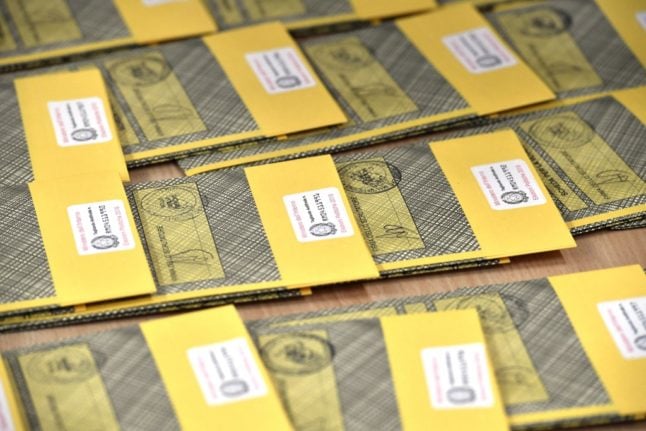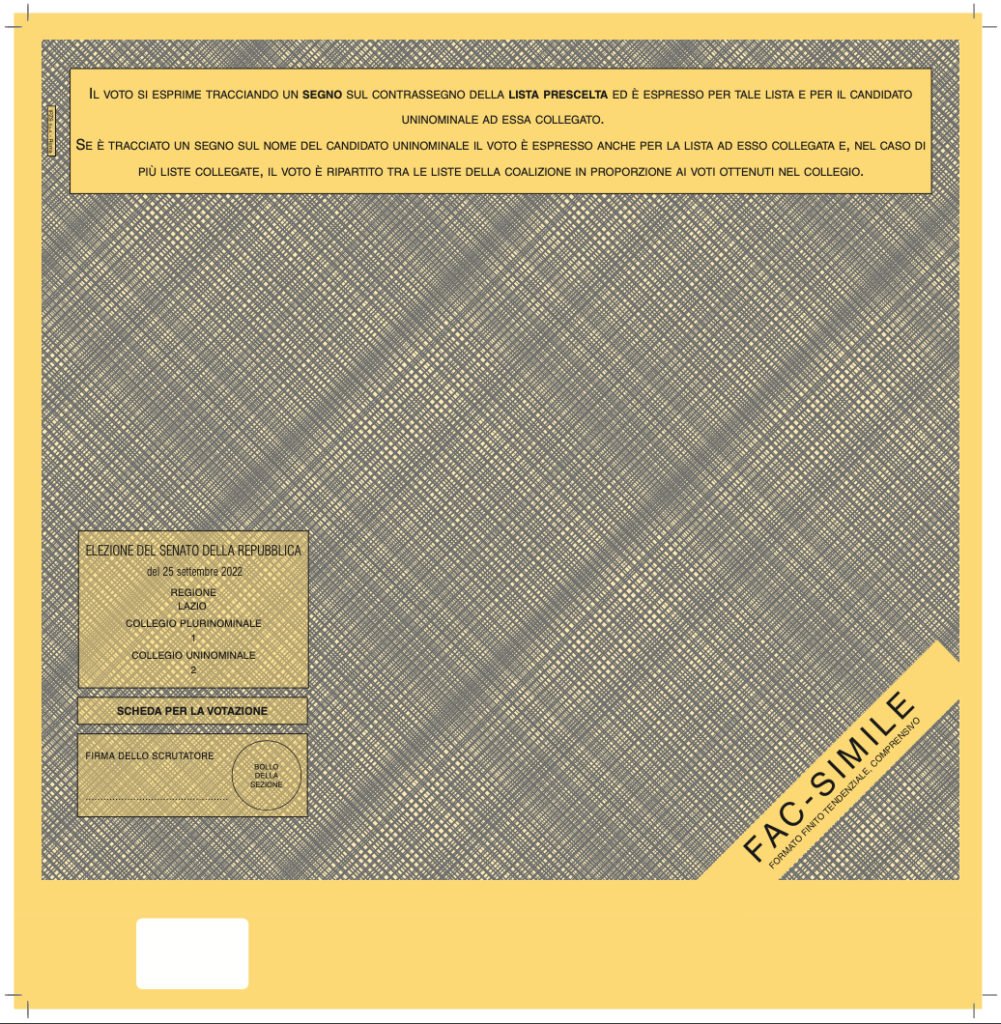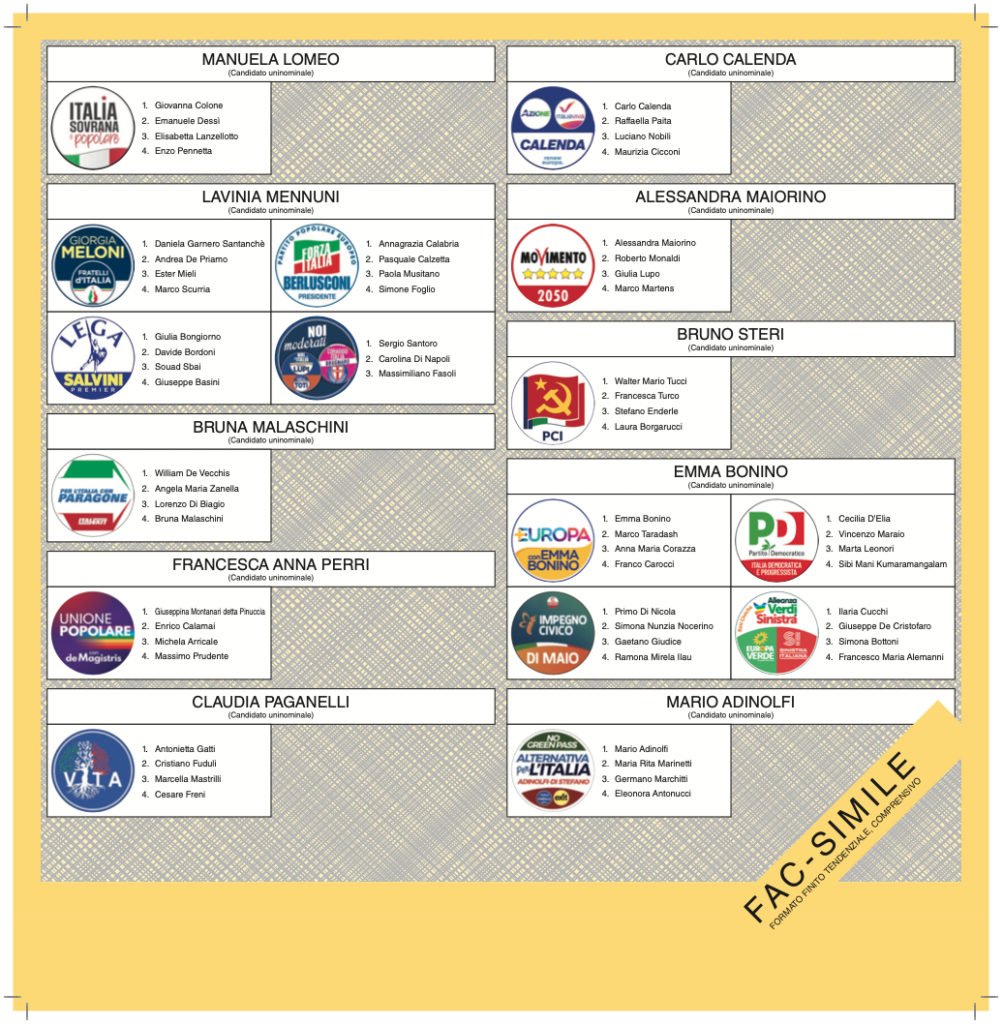Italian ballot papers: What they look like and how to vote

With just a few days to go to Sunday’s general elections, here’s a look at Italy’s surprisingly tricky ballot papers and how to fill one out.
Italy’s general elections are just around the corner, with polling open between 7am and 11pm on Sunday, September 25th.
Many things have changed since Italy’s last general election, but ballot papers (schede elettorali) are not one of them and will have the same form and features they did last time.
READ ALSO: Who can vote in Italy’s elections?
But if this is your first time voting in Italy, or you just need a refresher, here’s a look at Italy’s somewhat complicated ballot papers and what you’re supposed to do with them.
First of all, voters get two electoral slips: a pink one for the Chamber of Deputies and a yellow one for the Senate. Inside, they’ll both look something like this.
First page of a Senate ballot paper including instructions on how to vote.
As shown in the above photo, party symbols are enclosed within white rectangles. Parties belonging in the same coalition are grouped together (as in the case of the parties making up the right-wing bloc). Next to each party are the names of the candidates.
How do you vote?
You might notice that the Italian ballot doesn’t feature checkboxes next to parties or candidates’ names for you to put your cross in, as is the case on ballots in some other countries.
On the Italian ballot, instead you draw the cross - or segno (mark) - on top of either:
- The symbol of your chosen party OR
- The name of a candidate written in uppercase letters. (Not lowercase - we’ll explain why below).
The ballot paper’s first page explains - in typical politichese (political jargon) - that you vote “by drawing a mark over the chosen party and it applies to said party and to the collegio uninominale [first-past-the-post] candidate associated with it.
“If a mark is drawn over a collegio uninominale candidate, the vote also applies to the party they’re aligned with; in the case of coalitions, the vote is divided between the parties making up the relevant coalition through the proportional system.”
At this point you might be understandably puzzled about what in the world a collegio uninominale (or first-past-the-post) candidate is.
The system is anything but simple: Italy has a mixed voting system with some seats allocated via proportional representation ('sistema proporzionale') and others by first-past-the-post ('uninominale secco').
READ ALSO: An introductory guide to the Italian political system
Because of this, there are two categories of candidates on Italian ballot papers.
The candidates whose names are written in uppercase run for collegi uninominali (single-member electoral districts), meaning that there’s only one parliamentary seat up for grabs and that seat is allocated via the first-past-the-post system.
On the other hand, candidates whose names are written in lowercase run for collegi plurinominali (multi-member electoral districts), meaning that there are multiple seats available – the number of seats depends on the size of a district’s population – and seats are allocated through a proportional system based on each party’s overall performance.

Italy has a mixed voting system with some seats allocated via proportional representation ('sistema proporzionale') and others by first-past-the-post ('uninominale secco'). Photo by Andreas SOLARO / AFP
Now, though Italian ballot papers include both categories of candidates, voters are not actually allowed to directly vote for proportional system candidates (in lowercase) and doing so would result in a spoilt (void) ballot.
It’s worth repeating that you can only vote by marking one of either your chosen first-past-the-post candidate (uppercase) or, alternatively, your chosen party with a cross.
So, why bother us with candidates we can’t vote for?
All voters get two votes, one for each parliamentary house (Chamber of Deputies and Senate). In both cases, votes cannot be split between the two electoral systems (first-past-the-post and proportional representation).
READ ALSO: Your ultimate guide to Italy’s crucial elections on Sunday
That means a vote for a first-past-the-post candidate (in uppercase) is also a vote for the party they’re aligned with and therefore for the corresponding proportional system candidates (in lowercase).
Similarly, a vote for a party (or coalition) is a vote for its proportional system candidates as well as its single first-past-the-post representative.

Voters cannot split their vote between the first-past-the-post system and the proportional one. Photo by Andreas SOLARO / AFP
That’s why Italian schede elettorali include the names of proportional system candidates even though voters cannot directly vote for them.
Useful Italian ballot-paper vocabulary
Scheda elettorale: Ballot paper
Candidato uninominale: Candidate for a single-member electoral district. Single-member districts only ‘offer’ one parliamentary seat, which is allocated directly through the first-past-the-post system (i.e. the candidate with the greater amount of votes takes the seat).
Candidato plurinominale: Candidate for a multi-member electoral district. These districts have multiple available seats that are allocated through a proportional system – parties performing better on a national level get to fill more seats in parliament.
Segno: The mark you make in order to vote. Generally this is a cross.
Lista prescelta: Chosen party
For more information about voting in Italy’s upcoming elections, see the interior ministry’s official website here.
Comments
See Also
Italy’s general elections are just around the corner, with polling open between 7am and 11pm on Sunday, September 25th.
Many things have changed since Italy’s last general election, but ballot papers (schede elettorali) are not one of them and will have the same form and features they did last time.
READ ALSO: Who can vote in Italy’s elections?
But if this is your first time voting in Italy, or you just need a refresher, here’s a look at Italy’s somewhat complicated ballot papers and what you’re supposed to do with them.
First of all, voters get two electoral slips: a pink one for the Chamber of Deputies and a yellow one for the Senate. Inside, they’ll both look something like this.
As shown in the above photo, party symbols are enclosed within white rectangles. Parties belonging in the same coalition are grouped together (as in the case of the parties making up the right-wing bloc). Next to each party are the names of the candidates.
How do you vote?
You might notice that the Italian ballot doesn’t feature checkboxes next to parties or candidates’ names for you to put your cross in, as is the case on ballots in some other countries.
On the Italian ballot, instead you draw the cross - or segno (mark) - on top of either:
- The symbol of your chosen party OR
- The name of a candidate written in uppercase letters. (Not lowercase - we’ll explain why below).
The ballot paper’s first page explains - in typical politichese (political jargon) - that you vote “by drawing a mark over the chosen party and it applies to said party and to the collegio uninominale [first-past-the-post] candidate associated with it.
“If a mark is drawn over a collegio uninominale candidate, the vote also applies to the party they’re aligned with; in the case of coalitions, the vote is divided between the parties making up the relevant coalition through the proportional system.”
At this point you might be understandably puzzled about what in the world a collegio uninominale (or first-past-the-post) candidate is.
The system is anything but simple: Italy has a mixed voting system with some seats allocated via proportional representation ('sistema proporzionale') and others by first-past-the-post ('uninominale secco').
READ ALSO: An introductory guide to the Italian political system
Because of this, there are two categories of candidates on Italian ballot papers.
The candidates whose names are written in uppercase run for collegi uninominali (single-member electoral districts), meaning that there’s only one parliamentary seat up for grabs and that seat is allocated via the first-past-the-post system.
On the other hand, candidates whose names are written in lowercase run for collegi plurinominali (multi-member electoral districts), meaning that there are multiple seats available – the number of seats depends on the size of a district’s population – and seats are allocated through a proportional system based on each party’s overall performance.

Now, though Italian ballot papers include both categories of candidates, voters are not actually allowed to directly vote for proportional system candidates (in lowercase) and doing so would result in a spoilt (void) ballot.
It’s worth repeating that you can only vote by marking one of either your chosen first-past-the-post candidate (uppercase) or, alternatively, your chosen party with a cross.
So, why bother us with candidates we can’t vote for?
All voters get two votes, one for each parliamentary house (Chamber of Deputies and Senate). In both cases, votes cannot be split between the two electoral systems (first-past-the-post and proportional representation).
READ ALSO: Your ultimate guide to Italy’s crucial elections on Sunday
That means a vote for a first-past-the-post candidate (in uppercase) is also a vote for the party they’re aligned with and therefore for the corresponding proportional system candidates (in lowercase).
Similarly, a vote for a party (or coalition) is a vote for its proportional system candidates as well as its single first-past-the-post representative.

That’s why Italian schede elettorali include the names of proportional system candidates even though voters cannot directly vote for them.
Useful Italian ballot-paper vocabulary
Scheda elettorale: Ballot paper
Candidato uninominale: Candidate for a single-member electoral district. Single-member districts only ‘offer’ one parliamentary seat, which is allocated directly through the first-past-the-post system (i.e. the candidate with the greater amount of votes takes the seat).
Candidato plurinominale: Candidate for a multi-member electoral district. These districts have multiple available seats that are allocated through a proportional system – parties performing better on a national level get to fill more seats in parliament.
Segno: The mark you make in order to vote. Generally this is a cross.
Lista prescelta: Chosen party
For more information about voting in Italy’s upcoming elections, see the interior ministry’s official website here.


Join the conversation in our comments section below. Share your own views and experience and if you have a question or suggestion for our journalists then email us at [email protected].
Please keep comments civil, constructive and on topic – and make sure to read our terms of use before getting involved.
Please log in here to leave a comment.